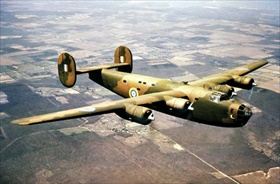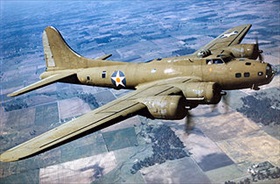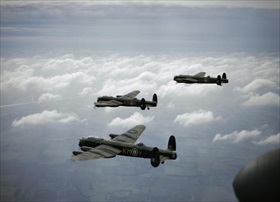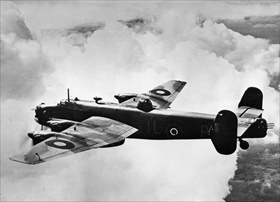CONSOLIDATED B-24 HEAVY BOMBER MAKES MAIDEN FLIGHT
San Diego, California • December 29, 1939
On this date in 1939 a prototype 4‑engine heavy bomber took off from San Diego’s Lindberg Field on its maiden flight. The flight lasted 17 minutes. Designed by Consolidated Aircraft, the prototype was initially known in-house as Model 32. Besides its distinctive twin tails and slab sides that allowed for capacious twin bomb bays, it was equipped with a tricycle undercarriage for faster takeoffs and landings and a thick, shoulder-mounted, low-drag patented “Davis” wing that increased the plane’s speed, range, and load capability over contemporary bomber aircraft like the Boeing B‑17 Flying Fortress. Earlier in 1939 the U.S. Army Air Corps selected the Model 32 following a rigged design study only Consolidated could win and in March ordered a single experimental XB‑24 bomber. Later that year the Army ordered 38 B‑24As, which had improved aerodynamics for better performance. Only 29 were produced, with 20 being sold to the Royal Air Force as LB‑30Bs (see photo essay below).
More modern than the legendary Boeing family of 4‑engine “Forts,” Consolidated’s B‑24D, the first model produced on a large scale, entered U.S. military service in 1941 as a potential replacement for the B‑17. Of course, it never came to that. Both airplanes were products of 1930s’ aeronautical engineers, but the ungainly “Flying Boxcar,” as the B‑24 was nicknamed, proved more rugged, had greater endurance, and outdid its Boeing compatriot in speed and operational range. Long-range B‑24s (meaning they could fly 1,540 miles/2,478 km with normal fuel and maximum internal bomb load of 12,800 lb/5,806 kg) also carried upward of two-thirds more ordinance by weight than long-range Flying Fortresses. Though both heavy bombers were mainstays of the U.S. strategic bombing campaign in Western Europe, the Liberator’s longer range proved useful in bombing operations in the Asia-Pacific theater, which grew to include the Japanese Home Islands. Very long-range (VLR) antisubmarine Liberators played an instrumental role in shrinking the mid-Atlantic “gap,” considered by U‑boat captains to be safe from land-based attack aircraft, and helping win the Battle of the Atlantic. With a maximum fuel load of 2,500 gallons/9,464 liter, a Liberator could spend 3 hours patrolling more than 1,100 miles/1,770 km from base, an hour more and almost twice the distance from base compared with Lockheed Hudsons and British Wellingtons, Armstrong Whitworth Whitleys, and Sunderlands.
A total of 19,203 B‑24 variants were manufactured at 5 U. S. facilities, making the Liberator the world’s most-produced bomber, heavy bomber, and multi-engine aircraft in U.S. military history. (Britain’s Royal Air Force conferred the name “Liberator” on the B‑24, and the name was embraced by the U.S. Army Air Forces.) Besides Consolidated Aircraft’s California plant, B‑24 Liberators were built by Consolidated in Fort Worth, Texas; Douglas Aircraft (now Boeing) in Tulsa, Oklahoma; North American Aviation (now part of Boeing) in Dallas, Texas; and Ford Motor Company at Willow Run near Ypsilanti, Michigan. More than 42,000 workers at the 3.5 million‑sq‑ft/325,161‑sq‑m Ford plant, believed to be the largest factory under a single roof, built just under half the world’s Liberators: 6,792 complete planes and 1,893 knock-down kits. At peak production, the Ford assembly line, over 1 mile/1.6 km long, churned out B‑24s every 51 to 59 minutes, a rate so high that the “arsenal of democracy” itself was unable to consume all the output, an embarrassment of riches. Besides the United States, major B‑24 consumers were Great Britain, Canada, Australia, and South Africa. Liberators were recorded as having dropped over 630,000 tons of bombs and downing several thousand enemy aircraft with their guns.
U.S. and British Heavy Bombers During World War II
 |  |
Left: Rare color photo of a preproduction B‑24 prototype wearing British rondelle. Six were sold to the UK directly and designated LB‑30A (LB signifying Land Bomber). Far more B‑24 Liberators were produced and were used more extensively than Boeing B‑17 Flying Fortresses, both in strategic bombing campaigns, on long-range antisubmarine patrols, and as transports (C‑87s). In fact, only in the U.S. Eighth Air Force were B‑17s predominant in number. So many historians have focused on the war in Europe, devoting much paper and ink to the 4‑engine Boeing bomber, that the B‑17 is often thought to be the only American long-range bomber of the war until the much larger Boeing B‑29 Superfortress was put in service in May 1944. Ironically, the more modern B‑24 was designed to replace the B‑17, with vastly improved performance owing to a shoulder-mounted, low-drag, aerodynamically shaped wing (Davis wing) that afforded higher speeds, greater fuel efficiency and explosive payloads, and superior operational range. Conversely, the B‑17’s large wing area (25 percent larger) made the plane easier to fly and at higher altitudes than the B‑24, but it produced considerable drag, limiting its speed and severely reducing its operational range. Also, the B‑24 had a higher accident rate than the B‑17, giving it another nickname: “Widow Maker.”
![]()
Right: By the time the U.S. entered World War II in December 1941 the Boeing B‑17 Flying Fortress was outdated based as it was on 1920s-early 1930s technology. Some 12,731 B‑17s were produced between 1936 and 1945. First flown in combat by the Royal Air Force over Europe, the British found the B‑17’s performance dismal and preferred flying the Consolidated B‑24/LB‑30 Liberator. B‑17s flew with the U.S., British, and Soviet air forces. The German Luftwaffe even flew a dozen captured ones. Flying Fortresses were armed with 13 .50‑caliber/12.7‑mm M2 Browning machine guns in 8 positions. Depending on the distance of the mission, a B‑17 could carry between 4,000 and 8,000 lb/1,814 and 3,629 kg of bombs. (Loaded with a 6,000‑lb/2,722‑kg bombload, it had a range of 2,000 miles/3,219 km.) More bombs were dropped by B‑17s than by any other U.S. aircraft in World War II. Of the 1.5 million metric tons of bombs dropped on Nazi Germany and its occupied territories by U.S. aircraft, 640,000 tons were dropped from B‑17s. During the course of the war more than 5,000 B‑17s were shot down by German fighter planes or flak batteries.
 |  |
Left: Three RAF Avro Lancaster B.Is based at Waddington, Lincolnshire, fly above the clouds, September 29, 1942. Introduced into service in February 1942, 7,377 of these 4‑engine “Lancs” were built. They became the main heavy bomber used by the RAF as well as the most famous and successful of the war’s night bombers in contrast to the USAAF heavy bombers that were used mostly in daylight raids over occupied Europe. On the night May 16, 1943, a British squadron of 19 modified Avro Lancaster bombers (Mk.III), each with a 9,250‑lb/4,196‑kg payload of an externally mounted, specially designed “bouncing bomb” (actually a revolving depth charge), flew toward 3 dams on the Moehne and Eder rivers in Germany’s Ruhr Valley in the state of North Rhine-Westphalia. In a spectacular feat of precision bombing, the “dambusters” in Operation Chastise arguably performed the most audacious bombing raid of the European war, breaching 2 of 3 targeted dams. The Moehne dam alone spilled around 330 million tons of water into the western Ruhr region, devastating factories, munition plants, homes, mines, and farmland for miles/kilometers around. Bodies of at least 1,579 victims were found along the Moehne and Ruhr rivers, 70 in the Eder Valley, with hundreds of people gone missing. The RAF lost 8 Lancasters and 53 crewmembers in the Chastise raid.
![]()
Right: Squadron No. 35 was the first RAF squadron to use the Handley Page Halifax pictured above. The Halifax entered military service in November 1940. Squadron No. 35 carried out the first Halifax raid on March 10/11, 1941, over Le Havre, France. Both the Avro Lancaster (left frame) and the Halifax emerged as capable 4‑engine strategic bombers. Air Chief Marshal Sir Arthur Harris, since February 1942 head of RAF Bomber Command, deprecated the Halifax for its smaller payload, sharing as it did the same specification as the contemporary twin-engine Avro Manchester. Halifax’s stable mate Lancaster had the distinction of carrying the 22,000 lb/9,979 kg earthquake bomb called Grand Slam used by Bomber Command against hardened German targets toward the end of World War II. During their wartime service Halifaxes flew a total of 82,773 operations and dropped 224,207 tons of bombs, while 1,833 aircraft were lost. The Halifax was flown in large numbers by other Allied and Commonwealth air forces such as Canada’s, Australia’s, the Free French, and Poland’s.
The Story of Ford’s Willow Run and the Building of the B‑24 Bomber
![]()

 History buffs, there is good news! The Daily Chronicles of World War II is now available as an ebook for $4.99 on Amazon.com. Containing a year’s worth of dated entries from this website, the ebook brings the story of this tumultuous era to life in a compelling, authoritative, and succinct manner. Featuring inventive navigation aids, the ebook enables readers to instantly move forward or backward by month and date to different dated entries. Simple and elegant! Click
History buffs, there is good news! The Daily Chronicles of World War II is now available as an ebook for $4.99 on Amazon.com. Containing a year’s worth of dated entries from this website, the ebook brings the story of this tumultuous era to life in a compelling, authoritative, and succinct manner. Featuring inventive navigation aids, the ebook enables readers to instantly move forward or backward by month and date to different dated entries. Simple and elegant! Click 











